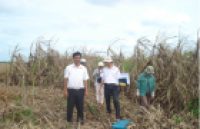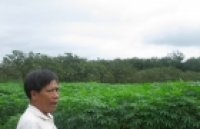| Common genetic basis for canopy temperature depression under heat and drought stress associated with optimized root distribution in bread wheat |
|
Previous research using a bread wheat RIL population of the Seri/Babax cross showed that common QTL were associated with cooler canopies under both drought and heat-stressed conditions. A subset of RIL was grown under water-limited and hot-irrigated field environments to test how cooler canopies are related to root development. Eight sisters and the two parents were used in the study with genotypes grouped as COOL or HOT according to their respective QTL for canopy temperature and previous phenotypic data. |
|
R. Suzuky Pinto, Matthew P. Reynolds Theoretical and Applied Genetics; April 2015, Volume 128, Issue 4, pp 575-585
AbstractKey messageQTL related to cooler canopy temperatures are associated with optimal root distribution whereby roots proliferate at depth under drought or near to surface under hot, irrigated conditions. Abstract
Previous research using a bread wheat RIL population of the Seri/Babax cross showed that common QTL were associated with cooler canopies under both drought and heat-stressed conditions. A subset of RIL was grown under water-limited and hot-irrigated field environments to test how cooler canopies are related to root development. Eight sisters and the two parents were used in the study with genotypes grouped as COOL or HOT according to their respective QTL for canopy temperature and previous phenotypic data. Root mass production and residual available soil moisture were measured around anthesis at four depth profiles (from 0 to 120 cm depth). When considering different root profiles, there was a clear interaction of QTL with environment. Under water stress, the COOL genotypes showed a deeper root system allowing the extraction of 35 % more water from the 30–90 cm soil profile. The strategy under heat was to concentrate more roots at the surface, in the 0–60 cm soil layer where water was more available from surface irrigation. Since COOL genotypes showed better agronomic performance, it can be concluded that their QTL are associated with more optimal root distribution in accordance with water availability under the respective stresses. The study demonstrates the importance of root development under both water-limited and hot-irrigated environments, and shows a common genetic basis for adaptation to both stresses that appears to be associated with sensitivity of roots to proliferate where water is available in the soil profile.
See: http://link.springer.com/article/10.1007/s00122-015-2453-9
|
|
|
|
[ Tin tức liên quan ]___________________________________________________
|


 Curently online :
Curently online :
 Total visitors :
Total visitors :
(12).png)


